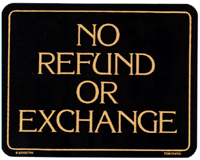 If you’re selling a product, returns are part of your business. A very important part of your business – like it or not. In many instances the way you handle a return from a customer dictates whether that customer is going to be ordering from you again or not.
If you’re selling a product, returns are part of your business. A very important part of your business – like it or not. In many instances the way you handle a return from a customer dictates whether that customer is going to be ordering from you again or not.
Recently the topic of returns came up on one of the eCommerce forums I follow. One store owner was complaining about the sheer number of returns they get, while another was complaining about how much money they lose on return shipping.
While none of us want to risk losing a customer over a return, there are certain things we can to to prevent them and not turn them into a loss:
- Describe the Merchandise. Unlike a traditional brick-and-mortar store, eCommerce doesn’t give the shopper the ability to touch and feel your merchandise, therefore well written and accurate product descriptions are important. To reduce the number of returns, take the time to write very detailed descriptions of your products that include dimensions, material type (if applicable), all known features and functionality and even ingredients (if applicable). Make it an internal policy that when customer service representatives get asked questions about a product that those questions and answers are worked into the product description.
- A Picture Tells A Thousand Words. The best product description in the world won’t sell a single product if there’s not a good image to associate with it. Take the time to take photographs of your products at different angles and also close ups of certain features or detail areas that you feel are important selling points. Most shopping carts allow for the use of multiple images, so take advantage of it. If you don’t have a photo for a product, don’t put the product up for sale until you do.
- Policy Clarity. Every eCommerce store needs to have a return policy, but how difficult you make it on the customer is important for business. For most businesses, returns should be allowed within a certain time frame as long as the merchandise is not worn, is free of dirt or debris, includes any tags and is accompanied by its original packaging. Most businesses make the customer pay for the return, which is acceptable, unless a damaged or incorrect item was sent. In some rare instances businesses, such as Zappos.com, will pick up the shipping on the return – but profit margins need to support that. If you require an RMA make sure you note that in your policy as well as any penalty for returning an item without one. If a restocking fee applies for some or all merchandise, that should be noted as well.
- Ask Why. Why is a customer returning an item? You should want to know so you can prevent the next person who buys that item from returning it. Once you have the reason, see what steps you can take internally or on your website to reduce the number of future returns for that item.
- Bargain. Many times a customer may want to return an item because they just don’t like it, it wasn’t as expected, or they found it cheaper somewhere else. Rather then go through the hassle of initiating the return process, work with the customer to avoid the return. See if they will keep the item in return for some money back in the form of a credit to their card or a coupon for something off their next order. You may be surprised at how many people will accept this, rather than make a return.
